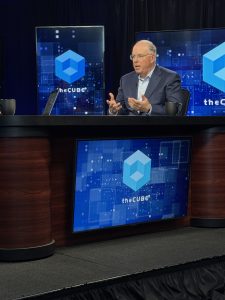 AI
AI
 AI
AI
 AI
AI
Enterprise observability is becoming a make-or-break capability for artificial intelligence. Riverbed Technology LLC aims to cut through the noise with a unified platform that delivers measurable outcomes for performance-hungry enterprises in a market bloated with tools and buzzwords.
The company’s engineering collaboration with Intel Corp. is a key driver behind this evolution. The partnership has given the company exclusive access to low-level system interfaces, empowering new levels of enterprise observability, diagnostics and real-time performance insight that other vendors can’t offer, according to Dave Donatelli (pictured, right) chief executive officer of Riverbed.

Riverbed’s Dave Donatelli talks with theCUBE about the company’s unified observability platform and its partnership with Intel.
“We’ve had a great relationship with Intel,” he said. “They run their business on our products, they use our products … great engineering relationship. They’ve opened those interfaces up to us. We did joint development together.”
Donatelli spoke with John Furrier (left), during an exclusive conversation on theCUBE, SiliconANGLE Media’s livestreaming studio. They discussed Riverbed’s unified observability platform, the Intel partnership and how performance visibility is evolving to meet enterprise AI demands. (* Disclosure below.)
Riverbed’s platform begins at the data layer, but its real intelligence comes from its IQ engine — a decision-making layer fueled by real-time telemetry collected from network performance tools, application infrastructure and endpoints, according to Donatelli. This information feeds into the company’s patented Riverbed Data Store, which ingests both native and third-party data at enterprise scale, enabling analytics capabilities that support AI workloads.
“Our data store … pulls all from that first layer … [and] the IQ engine is where we apply all the algorithms to it,” Donatelli said. “We can do what we call automations and remediations, we can do agentic AI, we can do predictive AI [and] we can do generative — all using IQ.”
Now in its third generation, IQ sits atop the Riverbed Data Store and acts as the control tower for data-driven actions. Organizations are already seeing an impact in areas such as automated problem resolution and performance optimization, according to Donatelli.
“We have done more than 64 million real-world automated events for customers,” he said. We have more than 39 customers already, and this list grows every month, of people doing more than 10,000 remediations every month.”
Riverbed’s Smart OTel technology brings a new level of precision to enterprise observability. Built on OpenTelemetry protocols and powered by the company’s IQ engine, it enables organizations to fine-tune what data they collect, how it’s filtered and where it’s sent, cutting through noisy telemetry streams and helping teams focus on the information that actually matters, according to Donatelli.
“They don’t want to be flooded … the beauty of the IQ algorithms is they can just precisely get exactly what they’re looking for,” he said. “Instead of just getting a flood of raw data, we’re going to give them more precise data … [and] slice it any way you want in order for whatever the project is within your company.”
The company’s Unified Agent applies the same simplification mindset to the observability infrastructure. Rather than layering countless individual software agents on users’ machines, Riverbed now offers a single consolidated agent that supports plug-and-play modules, according to Donatelli.
“We’ve reined them in by having a common agent,” he said. “[Last year], we announced three modules … now we just announced three more agents.”
One of the most notable additions is the Intel diagnostics module, developed in partnership with Intel to provide low-level visibility into Thunderbolt and Wi-Fi performance. No other vendor has access to those interfaces, and the engineering work required makes this capability uniquely Riverbed’s, according to Donatelli.
“Now our products can see all the way through, help again, identify problems, diagnose [and] resolve,” he said. “[That’s] a module that will go into our Unified Agent.”
As unified communications become mission-critical for video-heavy enterprises, Riverbed’s ability to monitor and fix problems before they happen sets it apart from traditional, reactive platforms that struggle to support enterprise observability in real time, according to Donatelli. Predictive diagnostics ensure that high-level calls don’t get derailed by performance issues.
“We can monitor in real time, which is [to] understand things as they’re happening to fix them,” Donatelli said. “But more importantly, we can do predictive.”
The company is also seeing a resurgence in its core acceleration business, driven by enterprise AI’s growing appetite for data movement, Donatelli added. While previous network upgrades reduced demand for acceleration, the tide has turned as organizations now struggle to move massive datasets efficiently across traditional infrastructure.
“People are seeing they have to move so much data that they need new solutions,” Donatelli said. “What we’re doing, from a technology perspective, our biggest launch in seven years … all new products across the board … [is] around helping people with AI in this space. Regardless of how fast your network is, most people are running traditional apps … and [they] can’t take advantage of the speed. Guess what they need to run well? Acceleration.”
Riverbed’s customers aren’t just seeing technical gains; they’re reporting dramatic shifts in support efficiency and problem resolution, according to Donatelli. As adoption expands across industries, performance metrics that speak directly to enterprise pain points are surfacing. These outcomes also reflect Riverbed’s ability to deliver enterprise observability with measurable impact.
“A large bank has eliminated 75,000 calls to their help desk per month,” Donatelli said. “With that, they’ve reduced their mean time to repair … by 25%. “[A] big healthcare company had 10,000 endpoints. Same idea: Their view is each call they get on any of these circumstances is 20 minutes of time minimum to fix. We’ve been reducing that 20 minutes time and taking it away because now we can fix things proactively that they don’t have to touch.”
Here’s theCUBE’s complete video interview with Dave Donatelli:
(* Disclosure: Riverbed Technologies LLC sponsored this segment of theCUBE. Neither Riverbed nor other sponsors have editorial control over content on theCUBE or SiliconANGLE.)
THANK YOU